Papaya can be considered a fruit tree that lives fast and dies hard. These fast-growing trees will produce fruit in the first year of planting if given the right conditions. However, several hours of sub-freezing temperatures can kill an unprotected plant. They are easy to grow, quick to fruit, and all year round. Papayas are fast-growing shade trees and look good too.
If you’re interested in growing your Papaya, you’ll need to find a Papaya seed first. You can buy seeds either online or from a local store. Once you have the seed, you’ll need to plant it in a pot or ground, and then you’ll need to water and fertilize it regularly. In a few months, you’ll start to see fruits growing.
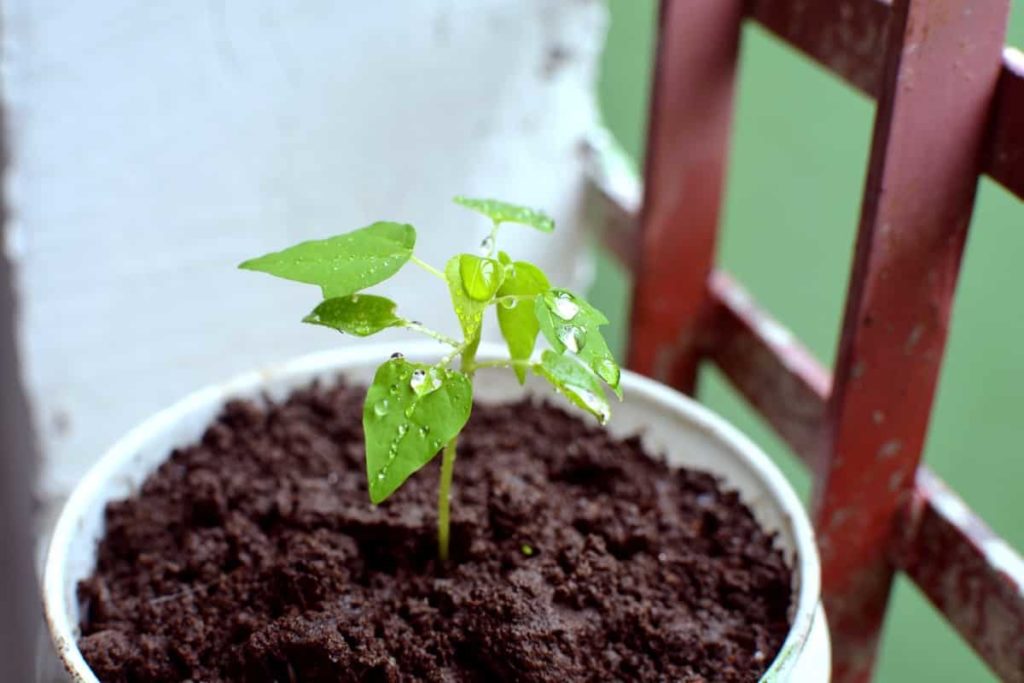
How to grow Papaya from seed to harvest
How long does it take to grow Papaya from seed to fruit?
- The climate plays a key role in the number of months Papaya needs to grow and give ripe fruits. It will bear fruit in six to nine months to harvest after planting seeds in hot areas, but in more temperate areas take nine to eleven months to produce fruit when grown from seeds.
- The Papaya fruit should be harvested after the color breaks when some appear on the yellow fruit but before completely yellowing (about 9 to 14 months after planting). The best fruit for harvesting for home use is done when it is half-yellow. If left to ripen on the tree, fruit flies and birds often spoil the fruit.
- To grow good Papayas, you need a frost-free climate, a lot of sunlight, water, and good soil. If you can supply all the facilities, at any time of the year, you can stick some Papaya seeds to the ground, and after six to ten months, they will start bearing fruit.
- The amount of fruit produced from the Papaya plant varies with the general climate, weather conditions during the year, and plant care. With the right conditions, Papaya plants can live for nearly 20 years. Papaya trees require a tropical climate to grow and produce fruit successfully. Papaya trees can last for many years if they get the right conditions.
Does Papaya grow true from seed?
- You can use any purchased Papaya for seeds, but you get the best results using locally grown Papaya fruit seeds. Papayas are usually produced from seeds, so there are some true varieties.
- Supermarket Papaya will give several hundred black seeds. Seed-grown plants will sprout in about two weeks and move towards flower maturity in just five to six months.
- Growing Papaya trees is usually done with seeds extracted from ripe fruit. If you’re using fruits from a grocery store, they contain both male and female parts in the plant. You should plant several seeds per pot to ensure growth. Under full sunlight, the seedlings can emerge in about two weeks. Plants can be taken out after being one foot long and spaced at a distance of 8 to 10 feet. The seedlings will flower after five or six months.
What is the fastest way to germinate Papaya seeds?
- Soak the Papaya seeds in a potassium nitrate solution for about 30 minutes. Soak the seeds in hot water at 70°C for 15 seconds if you have trouble finding potassium nitrate; then soak them in distilled water for 24 hours at room temperature to increase the germination rate. The seeds germinate in about two weeks. Transfer the seedlings to larger containers if they become crowded.
- Place them in seed-starting soil and keep them moist and warm for Papaya seeds to sprout. When the seedlings are a few inches long, transplant them into large boxes and grow them as a house plant.
In case you missed it: Papaya Gardening For Beginners – Planting FAQs
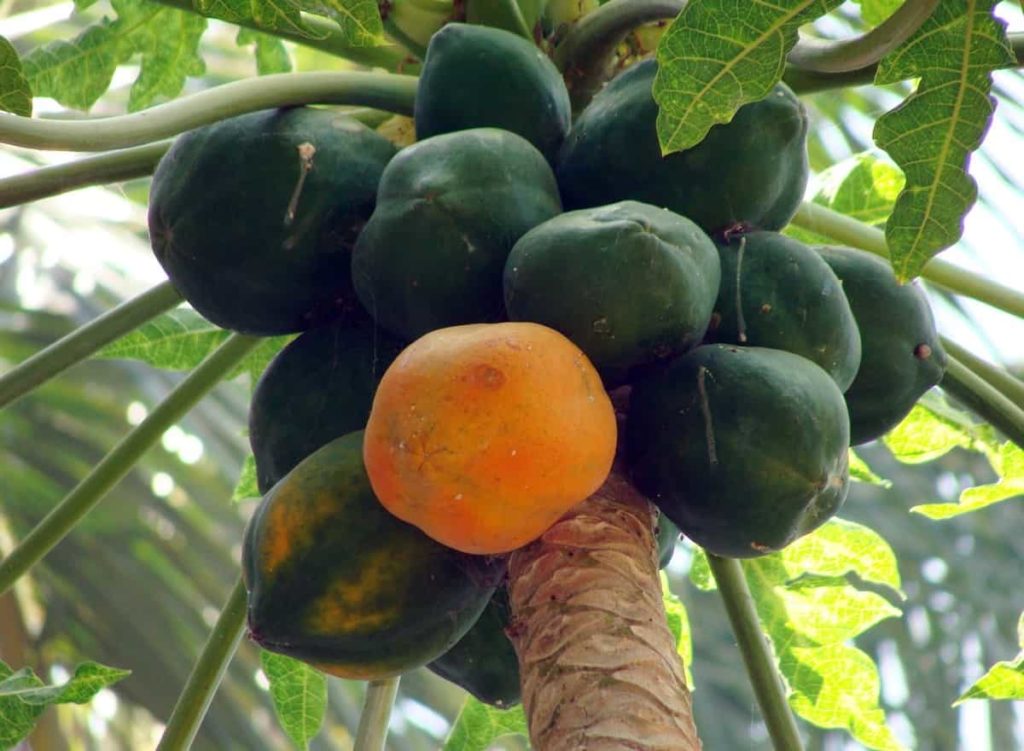
Do Papaya trees need a lot of water?
- Papayas have large soft leaves; in hot weather, much water evaporates, so they need more water than average. Papayas work best in rich soils that are high in organic matter. Ensure your planting site and soil have good drainage to avoid root rot.
- Initially, the water needed for Papaya plants may be limited for drought prevention, but in the bearing stage, the plant needs 25 to 35 liters of water daily.
- Papayas require a little water. However, if water is given every two weeks in the dry season, they provide more and more large fruits. If they don’t get enough water, the flowers will fall.
- If growing in loamy, you should water it every three or four days, but if your Papaya plant is growing in sandy, well-drained soil, it must be watered regularly during the growing season. This means every other day, even if the weather can be hot and dry.
- There is no need to water the Papaya plant during the rainy season. Water Papaya tree every 8 to 10 days in winter and twice a week in summer. Drainage is essential; waterlogging can lead to collar roots. Land at the base of the tree and drain excess water.
What month do you plant Papaya?
- The best season for Papaya plantations is monsoon (June and July). You can also plant in spring (February and March) and autumn (October and November). However, monsoon is the best season for it. It is usually practiced at a distance of 1.8 x 1.8 meters. To grow good Papayas, you need a frost-free climate, a lot of sunlight, water, and good soil. If you supply all the facilities at any time of the year, you can stick some Papaya seeds to the ground, and after six to ten months, they will start bearing fruit.
Does Papaya need full sun?
- Papaya grows best in the sun. Papayas love heat and sunlight. You should plant Papaya on a house’s south or southeast side, with some protection from wind and cold weather. Papayas also grow best in full sunshine. Papaya is like well-drained soil; growing Papaya trees due to shallow roots will not tolerate wet conditions.
- Papaya should be planted in full sunlight and at least 7 to 10 feet away from other plants, buildings, and power lines. Planting 2 to 3 Papayas 7 to 12 feet away from each other will ensure that at least one will be fruitful and facilitate fertilizing and watering.
- Any weather factor, such as cold or cold temperatures, dehydration (drought), constant strong winds, or shade, will reduce the growth and production of Papaya. Papaya plants grow best in temperatures ranging from warm to hot, 21°C to 32°C.
What is the best fertilizer for Papaya tree?
- A 14-14-14 fertilizer, given in 113 grams increments every six months, is the best fertilizer for Papaya trees. Compost is an excellent option because it provides nitrogen to the Papaya tree, increases drainage, and produces wet, rich soil.
- You should apply fertilizer once every two months for Papaya. Although fertilizer application to a particular region depends on soil and leaf analysis, each plant is recommended for each plant. Usually, 90 grams of urea, 250 grams of superphosphate, and 140 grams of Muriate of potash per plant.
- Once the plants have seven to eight months of age, 450 to 900 grams of Papaya 14-14-14 fertilizer per plant every other month and passed from the drip line to the upper layer of the soil. Work and then water the trees thoroughly.
- Newly planted Papaya trees require phosphorus for proper root formation and growth. When planting your Papaya tree, add 450 grams of treble superphosphate to the planting hole. First, dig a hole about 3 feet wide and 8 inches deep. Then put the superphosphate under the hole before planting the Papaya tree.
- Compost serves many purposes. It directly feeds the Papaya tree with essential nutrients, including nitrogen. It also helps improve drainage and creates moist, rich soil conditions that Papaya trees prefer. When planting, add 900 grams of compost to the bottom of the planting hole before planting your Papaya trees.
In case you missed it: Growing Papaya In Polyhouse – Greenhouse In India
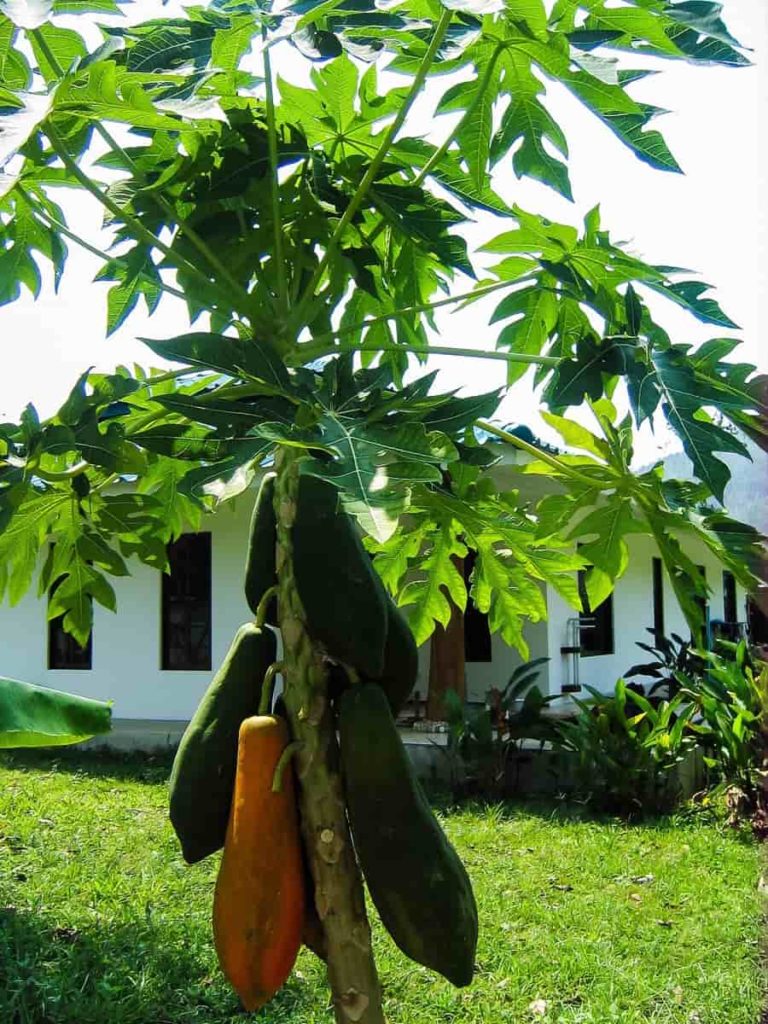
Why do baby Papayas fall off the tree?
- Most of the time, it is a natural process where small immature fruits fall because they are not fertilized. In some cases, unfavorable weather conditions such as high or low temperatures, water pressure (excess or less water), insects, and disease can cause fruit falls.
- Papaya trees like water but not too much. Give too little to these tropical plants, and water stress can cause fruit loss in Papaya. On the other hand, if Papaya trees get a lot of water, you will also see your Papaya falling fruit. If the growing area is flooded, it explains why your Papaya fruit is falling.
How often do Papaya trees produce fruit?
- On Papaya plantations, which are usually found in tropical areas, while it is fruit-bearing, a Papaya tree often ripens three to four fruits a week. A healthy Papaya tree produces 34 kg of fruit yearly.
- Production varies widely according to the soil, climate, and garden management. Plants mature for six to nine months in hot growing areas and 9 to 11 months in cooler areas. A mature Papaya plant yields 100 fruits per growing season.
What is the best soil for Papaya?
- Papaya grows well in well-drained, rich sandy loam soil with a depth of 45 centimeters or medium black soil free from waterlogging. Light soil with a pH between 6.5 and 7 is great for Papaya if adequately manured.
- You should choose a nutrient-rich potting mix for tropical plants or make your mixture from garden soil and 25–50% compost. Papaya will continue to grow in sandy, loamy or rocky soil.
- You should avoid extreme conditions such as soils with high pH (8.0) and low pH (5.0). Papaya is highly susceptible to water accumulation, and the roots are damaged due to stagnant water.
Do you need to dry Papaya seeds before planting?
- It is easy to grow a common Papaya tree from seeds. Wash and squeeze the seeds from the jelly bag that covers each seed. The seeds will only grow if you remove the bag.
- In a sealed container, you can store seeds for up to three years, their viability decreases with age. There is no need to dry if you plan to grow seeds immediately.
- On weekends, roll the seeds around to remove the husks that cover the dry seeds, then store them in a cool, dry place. Place them in seed-starting soil and keep them moist and warm for Papaya seeds to germinate. The seeds germinate easily, and the plants will start growing faster.
Why is my Papaya tree not fruiting?
- Papaya requires warm weather, full sun, and moist, loamy soil to bear fruit. Temperatures below 15°C prevent blooms and can result in deformed fruit.
- Dehydration and excessive moisture can affect flower growth, pollination, fertilization, and fruit set. Uneven water supply to Papaya plants creates stress leading to uneven flowering and fruit set. Papaya trees in home gardens sometimes fail to bear fruit. This is not because the Papaya plant has unhealthy or low growth stress.
In case you missed it: Growing Dwarf Papaya from Seeds – A Full Guide
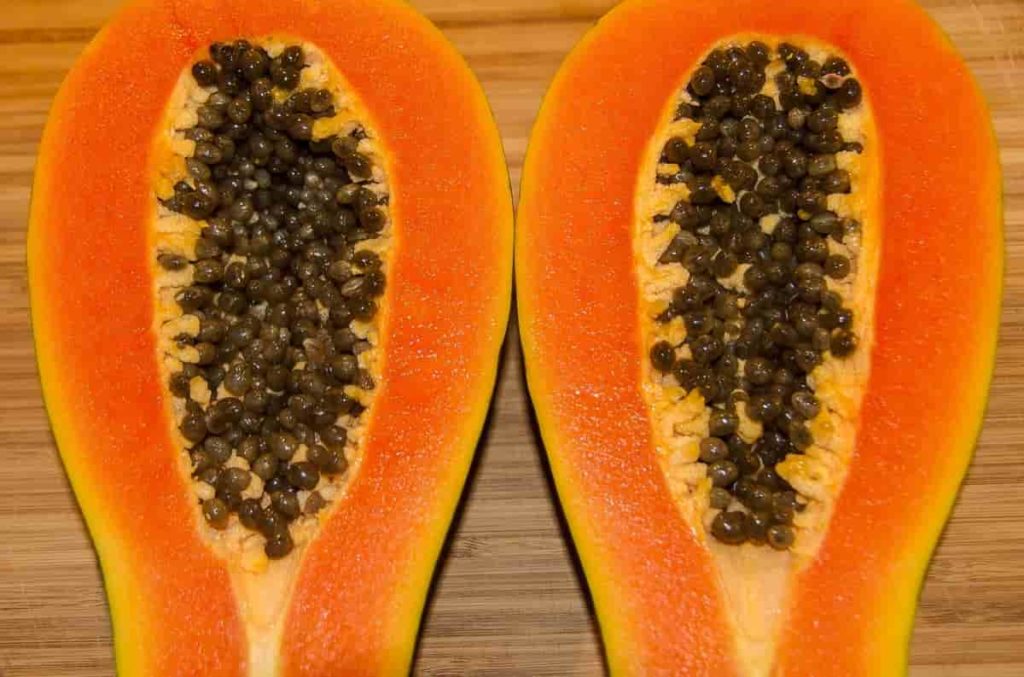
Can Papaya tree be grown in pots?
- Growing Papaya is not difficult in pots, considering it is a short, small tree with shallow roots. You can grow various varieties of Papaya in a pot and cut it from the top to shorten it. However, if you have options, it’s best to choose the dwarf type.
- You should plant Papaya on a house’s south or southeast side, with some protection from wind and cold weather. Papayas also grow best in full sunshine. Papaya is like well-drained soil; growing Papaya trees due to shallow roots will not tolerate wet conditions.
Should I trim Papaya leaves?
- Papaya plants are not pruned because their primary growing point is the terminal, and branched trees cannot produce either. However, side shoots may grow as Papaya plants mature and if exposed to environmental conditions that inhibit growth or if the primary growing point is damaged or killed.
- You should cut off any shoots that sprout from the base of the Papaya. If the Papaya tree is many years old and fruit production is slowing down, let a shoot grow after the harvest, usually in September.
- Revive a Papaya tree that has grown too tall by cutting the main stem in the spring, 3 feet from the ground. Cover the rest of the branch with a garbage bag to protect it from water or rain. Several shoots will sprout rapidly from the base of the Papaya. Choose the strongest shoot as a new main stem when the shoot is 1 foot long. Remove all other shoots.
- Remove the leaves of a broken or dead Papaya tree and their stems from anvil pruners or loopers. Loopers are commonly used on large stems less than 2 and 1/2 inches in diameter.
Why is my Papaya tree leaves turning yellow?
- A plant’s ability to perform basic functions, such as nutrient composition and absorption, depends on the presence of water in the soil. When plants don’t get enough water, their leaves turn yellow and eventually fall off.
- Papaya leaves turn yellow because of too much water or too little water, too much nitrogen, or too little, or Root grubs/nematode problems.
How deep are Papaya roots?
- The roots of Papaya trees are shallow, and they do not like to be submerged in water. When planting seeds, cover the seed with about a quarter inch of soil from your soil. The main thing is to dig a hole three times larger than the root ball, so the roots can spread.
- Papayas are adapted to practically any well-drained soil. Raised beds can partially overcome drainage problems. Although Papayas thrive best in the full sun, some relaxation can be given to protect against wind or cold weather.
- Papayas grow and produce well on different soil types. Under favorable conditions, the root system can penetrate to a depth of 2 meters, but most of the roots responsible for nutrient use are found in the top 500 millimeters.
How do you prevent worms in Papaya?
- Protect the fruit to prevent them from laying eggs as it ripens. Use paper bags or knee-high stockings to cover every fruit when young. You’ll have to throw away your infected fruit, but protect fruits that don’t have maggots and start covering the fruit early next year.
- Insects in your Papaya tree are caused by the fruit fly that lays its eggs in the tree’s flowers. You should spray your Papaya flowers with a pesticide containing Diazinon or Malathion insect spray and follow the manufacturer’s recommendation to mix the solution.
- Papaya fruits are damaged by fly maggots and Papaya webworms, also known as fruit cluster worms. Insects damage trees and fruits with their food and are among the serious pests of the fruit.
- Before Papaya flowers appear or as they appear, preventive fungicides can help control Papaya anthracnose. Use a fungicide containing copper hydroxide, mancozeb, azoxystrobin, or bacillus. Spray fungicides every two to four weeks in the garden.
In case you missed it: How to Prepare the Soil for Mango Trees: Tips for Best Soil Mix, pH, and Compost
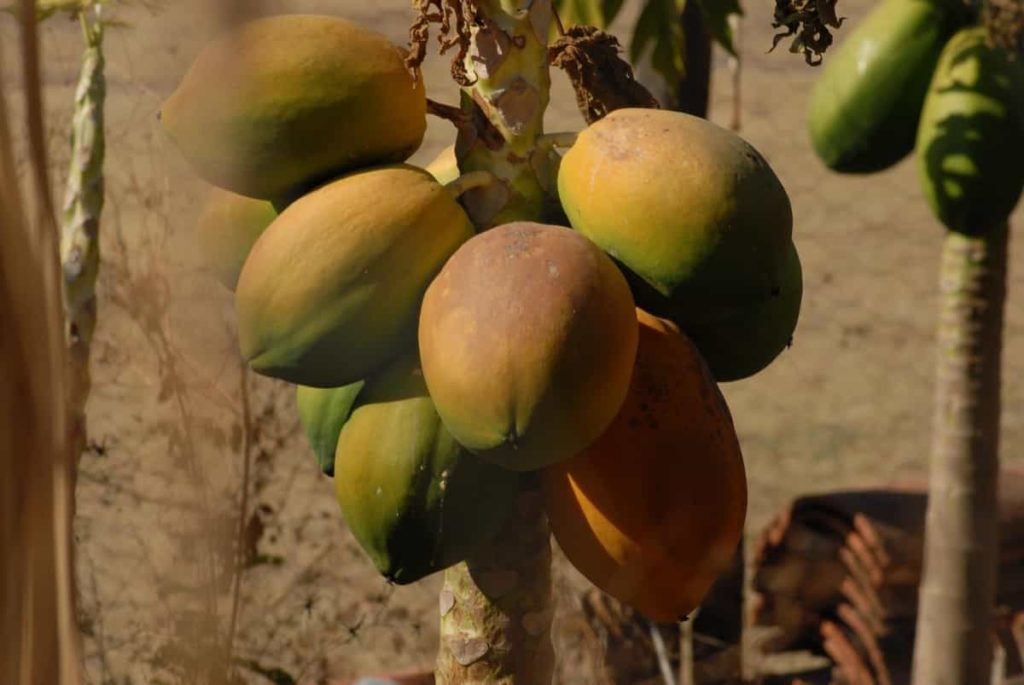
Do I need 2 Papaya trees?
- They are easy to grow, quick to fruit, and fruit all year round. Papaya does not need another tree for pollination because male flowers can pollinate female flowers on the same tree. However, Papaya trees will provide better fruit yield when an additional tree is nearby.
- There are two distinct types of Papaya plants. Most cultivars have both male and female flowers on separate plants, which both need to produce fruit.
Will Papaya ripen if picked green?
- At room temperature, Papayas will continue to ripen (and you can speed up the process by placing them in a paper bag), but if they’re completely green, it’s unlikely they’ll fully ripen.
- Simply placing your Papaya in a paper bag and stopping folding or rolling will make the fruit ripen within two to three days, depending on how green its start was. To speed up the ripening process for a day, add ethylene-producing fruits such as Apples or ripe Bananas to the bag.
How do you know when Papaya is ready to pick?
- Pick Papaya when you first see green skin turning yellow. When completely immature, Papayas are dark green. As they ripen slowly, the green skin turns into dark yellow skin.
- Cut the fruit grown for export 1/4 before it turns yellow. However, fruits taste best when the skin is 80 percent colored. Home growers should harvest when the fruit is between 1/2 and 3/4 and has a ripe color.
- Well-cared plants can start to flower four months after planting and 7 to 11 months after planting. The amount of fruit produced from the Papaya plant varies with the general climate, weather conditions during the year, and plant care. Yield varies from 28 to 36 grams per tree over 12 months.
In case you missed it: How to Grow Apples for Beginners: A Guide to Planting to Harvesting
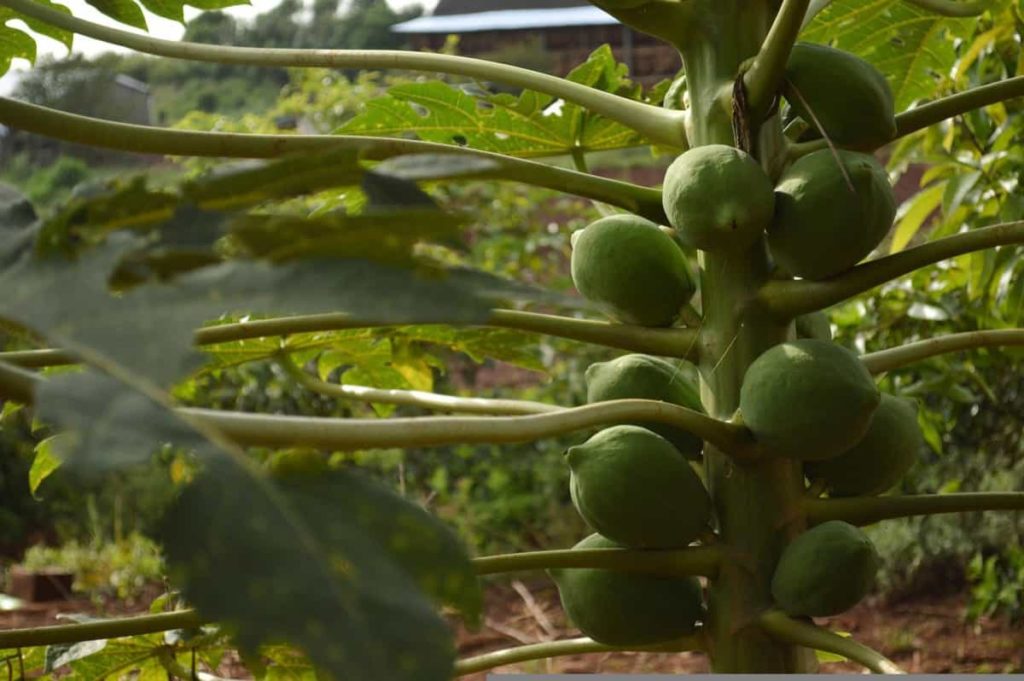
Conclusion
A great thing about Papaya is that it is a fairly easy fruit to grow and can be grown indoors and outdoors. Papaya trees can be up to 15 feet tall, so make sure you have enough space for them to grow. Consider growing Papaya if you are looking for delicious and nutritious fruits to grow in your garden. It is a fruit that people all over the world enjoy, and it is a fruit that is easy to grow.
- How to Grow Hibiscus from Flower
- Plantation Ideas for Home Decoration: A Beginners Guide
- Flower Garden Designs and Layouts for Beginners
- Planting and Spacing Techniques in Papaya: A Beginner’s Guide
- Growing Gold: Essential Techniques for Planting Pineapples
- How to Make Kalanchoe Plant Bushy: Home Remedies and Solutions
- 11 Reasons Why Your Gardenia is Not Blooming: Home Remedies and Solutions
- Eco Elegance: The Guide to Designing a Drought-Tolerant Landscape
- Gardening on a Slope: Strategies for Hillside Landscaping
- Nourish and Flourish: Top Organic Mulches for Thriving House Plants
- Everything You Want to Know about Indian Mogra Flower: Discover Uses and Growing
- Green Thumb Success: Expert Tips for Cultivating Greenhouse Pumpkins All Year Round
- Maximize Growth & Flavor: The Ultimate Guide to Companion Planting in Herb Gardens
- How to Control Rhododendron Problems Naturally: Home Remedies and Organic Ways to Fix Them
- Natural Magic: The Remarkable Benefits of Cinnamon for Plants
- Best Steps to Revive Dying Tulip with Natural and Organic Treatment
- 10 Reasons Why Your Angel Trumpet is Not Blooming: Remedies and Treatment
- How to Fix Periwinkle Leaf and Flower-Related Problems: Natural Remedies and Solutions
- How to Fix Zinnias Leaf and Flower Problems: Discover Natural and Home Remedies
- Organic Steps to Induce Lemon Tree Flowers: A Comprehensive Guide
- Bloom Booster: Crafting the Perfect Homemade Bougainvillea Fertilizer
- Optimizing Growth: A Guide to Applying NPK Fertilizer for Potted Plants
- 10 Best Homemade Fertilizers for Rubber Plant: DIY Recipes and Application Method
- How to Boost Female Pumpkin Flowers: Effective Steps for More Flowers and High Yields
- Transform Your Indoor Garden: Top Benefits of Pink Salt for Houseplants
- 10 Best Homemade Fertilizers for Peacock Plants (Calathea): Easy DIY Guide
- Unlock Blooms: 9 Reasons Why Your Potted Chrysanthemum is Not Blooming
- 8 Reasons Why Your Potted Hibiscus is Not Blooming: Fix it with Simple Solutions
- Unlock Blooms: 9 Key Reasons Your Potted Frangipani Won’t Flower
- 10 Reasons Why Is My Ice Plant Not Blooming: Remedies and Treatment
- 10 Reasons Why My Potted Hydrangea Not Blooming: Treatment and Remedies
- 10 Reasons Why is My Wisteria Not Blooming: Remedies and Treatment
- 10 Reasons Why is My Goldfish Plant Not Blooming: Remedies and Treatment
- Maximize Your Space: Ultimate Guide to Balcony Gardening with Grow Bags
- 10 Reasons Why Your Iris is Not Blooming: Remedies and Treatment
- 10 Reasons Why Your Anthurium Plant is Not Blooming: Treatment and Remedies